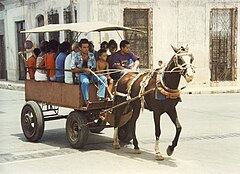This is an old revision of this page, as edited by 2a02:aa13:7200:9880:55b9:46a6:aa28:27b9 (talk) at 19:09, 6 June 2022 (LLL). The present address (URL) is a permanent link to this revision, which may differ significantly from the current revision.
Revision as of 19:09, 6 June 2022 by 2a02:aa13:7200:9880:55b9:46a6:aa28:27b9 (talk) (LLL)(diff) ← Previous revision | Latest revision (diff) | Newer revision → (diff) Economic crisis in Cuba after the fall of the Soviet UnionThis article has multiple issues. Please help improve it or discuss these issues on the talk page. (Learn how and when to remove these messages)
|
| Special Period Periodo especial | |
|---|---|
 Cuban citizens resorting to horse-drawn carriage for transportation (1994) Cuban citizens resorting to horse-drawn carriage for transportation (1994) | |
| Country | Cuba |
| Period | 1991–2000 |
| Refugees | Around 30,000 |
| Effect on demographics |
|
| Consequences |
|

In 1991, the Soviet Union collapsed, resulting in a large-scale economic collapse throughout the newly independent states which once comprised it. During its existence, the Soviet Union provided Cuba with large amounts of oil, food, and machinery. In the years following the collapse of the Soviet Union, Cuba's gross domestic product shrunk 35%, imports and exports both fell over 80%, and many domestic industries shrank considerably. Food and weapon imports stopped or severely slowed. The largest immediate impact was the loss of nearly all of the petroleum imports from the USSR; Cuba's oil imports dropped to 10% of pre-1990 amounts. Before this, Cuba had been re-exporting any Soviet petroleum it did not consume to other nations for profit, meaning that petroleum had been Cuba's orks. The lack of resources to purchase the electronic equipment to produce beats and tracks gives Cuban rap a raw feel that paralleled that of "old school" music in the US.
See also
- The Power of Community: How Cuba Survived Peak Oil
- Economy of Cuba
- Rationing in Cuba
- List of permaculture projects in Cuba
- Green anarchism in Cuba
- 1998 Russian financial crisis
- Lost Decade (Japan)
- Arduous March – the North Korean famine
References
- ^ Kozameh, Sara (30 January 2021). "How Cuba Survived and Surprised in a Post-Soviet World". Jacobin. Retrieved 2 February 2021.
{{cite web}}: CS1 maint: url-status (link) - Garth, Hanna. 2009 Things Became Scarce: Food Availability and Accessibility in Santiago de Cuba Then and Now. NAPA Bulletin.
- Carmen Diana Deere (July–August 1991). "Cuba's struggle for self-sufficiency – aftermath of the collapse of Cuba's special economic relations with Eastern Europe". Monthly Review. Archived from the original on 7 October 2007. Retrieved 20 January 2008.
- "Cuba's Special Period". www.historyofcuba.com.
- Pacini-Hernandez, Deborah and Reebee Garofalo. "The emergence of rap Cubano: An historical perspective." In Music, Space, and Place, editors Whitely, Bennett, and Hawkins, 89–107. Burlington, Vermont: Ashgate, 2004.
Sources
- Chavez, L. (2005). Capitalism, God, and a Good Cigar; Cuba Enters the Twenty-First Century. Durham and London: Duke University Press.
- Chiddister, Diane. (27 April 2006). Film shows many ways Cuba reacted to peak oil crisis Yellow Springs News. Retrieved 12 July 2014 (originally retrieved 18 October 2006)
- Heinberg, R. (2003). The Party's Over: Oil, War and the Fate of Industrial Societies. Canada: New Societies Publishers
- Hernandez-Reguant, A., ed. (2009). Cuba in the Special Period. Culture and Ideology in the 1990s. New York: Palgrave -Mac Millan.
- Lopez, M. Vigil. (1999). Cuba; Neither Heaven Nor Hell. Washington, D.C.: The Ecumenical Program of Central America and the Caribbean (EPICA).
- Pineiro-Hall, E. (2003) Seattle Delegation US Women and Cuba@ 5th International Women's Conference, University of Havana.
- Sierra, J.A. Time Table of Cuba 1980–2005, Retrieved 12 December 2006
- Zuckerman, S. (2003). Lessons From Cuba: What Can We Learn From Cuba's Two-Tier Tourism Economy?, Retrieved 26 November 2006
External links
- Cuba: Life After Oil
- Journeyman Pictures documentary Cuba - Seeds in the City - 22 min 47 sec (27 June 2003)
- Adam Fenderson interviews Pamela Morgan as she recalls her experiences in Cuba circa 1996
- Template:Ecured
| Cuba articles | |||||||||||
|---|---|---|---|---|---|---|---|---|---|---|---|
| History |
| ||||||||||
| Geography | |||||||||||
| Politics |
| ||||||||||
| Economy | |||||||||||
| Culture |
| ||||||||||
| Financial crises | |
|---|---|
| Pre-1000 |
|
| Commercial revolution (1000–1760) |
|
| 1st Industrial Revolution (1760–1840) |
|
| 1840–1870 | |
| 2nd Industrial Revolution (1870–1914) |
|
| Interwar period (1918–1939) |
|
| Wartime period (1939–1945) |
|
| Post–WWII expansion (1945–1973) |
|
| Great Inflation (1973–1982) |
|
| Great Moderation/ Great Regression (1982–2007) |
|
| Great Recession (2007–2009) |
|
| Information Age (2009–present) |
|